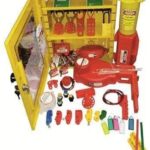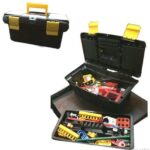Your list is empty, add products to the list to send a request
How Does the Fire Alarm Control Panel Work?

23
Jul
If you’ve ever wondered how the fire alarm control panel works, you’re not alone. This compact box on the wall is the heart of your fire detection system—and understanding it is key to fire safety.
Whether you manage a commercial space, a residential building, or an industrial site, the control panel plays a critical role in detecting danger and triggering life-saving alerts. In this guide, you’ll learn how it operates, what each part does, how to read it, and how to check if it’s working properly.
What Is a Fire Alarm Control Panel?
A fire alarm control panel (FACP) is the central unit that monitors and controls your entire fire alarm system. It receives signals from smoke detectors, heat sensors, call points, or sprinkler systems. When a threat is detected, it sounds the alarm, activates emergency devices, and displays which zone the issue occurred in.
Simply put—it’s the control centre that keeps your building safe 24/7.
How Does the Fire Alarm Control Panel Work?
The fire alarm control panel constantly scans all connected devices in your system. Here’s a step-by-step explanation of how it works:
- Monitoring – The panel continuously checks input devices (smoke detectors, call points, etc.).
- Signal Detection – When one of these devices is triggered, it sends an electric signal to the panel.
- Alarm Verification – The panel verifies whether it’s an actual fire condition, a fault, or a false alarm.
- Alarm Activation – If verified, the panel activates output devices such as sirens, strobe lights, sprinklers, or emergency messages.
- Zone Identification – The panel highlights the specific zone or address (in the case of addressable systems) where the event occurred.
- System Logging – The event is logged with date and time for recordkeeping and later investigation.
- Communication – Some systems notify the fire brigade, building management, or emergency response teams.
This cycle repeats every few seconds, ensuring real-time protection.
Main Components of a Fire Alarm Control Panel
To understand how it works, it helps to know the parts that make it function.
1. Display Screen
Shows system status, alarms, and faults. May be LED (basic) or LCD (advanced).
2. Control Buttons / Keypad
Used to acknowledge alarms, silence them, reset the panel, or perform tests.
3. Zone LEDs / Indicators
Lights up to show which area (zone) is affected—useful for large buildings.
4. Power Supply Unit
Supplies power to the panel and devices. Includes both AC power and backup battery.
5. Circuit Terminals
Where wires from detectors, manual call points, alarms, and other devices are connected.
Types of Fire Alarm Control Panels
Conventional Panel
- Divides the building into zones.
- Tells you which zone is triggered—but not the exact device.
- Best for small to mid-size buildings.
Addressable Panel
- Every device has a unique digital address.
- Shows the exact device and location triggered.
- Ideal for larger buildings and complex setups.
For instance, the Avani Addressable Fire Alarm Control Panel (RAVEL) is a feature-rich addressable panel ideal for large offices, hospitals, and multi-floor buildings.
How to Read a Fire Alarm Panel
Understanding the panel’s display and indicators can save lives. Here’s how to read it:
Look at the Main Display
- “Normal” – Everything is okay.
- “Fire” or “Alarm” – A fire has been detected.
- “Fault” or “Trouble” – Something isn’t working (battery low, device disconnected, etc.).
- “Supervisory” – A condition needs attention but isn’t an alarm (e.g. sprinkler valve closed).
Check Zone or Address
- Conventional panels show a zone number (e.g., “Zone 3 Alarm”).
- Addressable panels show device name and location (e.g., “Smoke Detector, Server Room”).
Read LED Indicators
- Red lights: Fire alarm active.
- Yellow lights: Trouble or fault.
- Green lights: Power is good.
How to Check Fire Alarm Control Panel
Routine checks are important to ensure your system works when needed. Follow these steps:
Daily:
- Ensure power light is green.
- Check for any fault indicators.
- Confirm the display says “Normal.”
Weekly:
- Test one device from each zone (e.g. press a call point or use smoke test spray).
- Confirm that alarms trigger and panel shows the correct location.
- Reset system after test.
Monthly:
- Open panel and inspect wiring and battery connections.
- Run a full system test with backup battery.
- Keep logs of test results and maintenance.
Annually:
- Have a certified technician perform a deep inspection and servicing.
- Replace backup batteries if required.
Fire Alarm Panel User Modes
Most control panels have different access levels:
- User Mode – Basic controls like silence, acknowledge, and reset.
- Installer Mode – Setup device addresses, timers, logic sequences.
- Engineer Mode – Advanced diagnostics and configuration (restricted).
Always refer to your system manual or a qualified technician when changing advanced settings.
Advantages of a Fire Alarm Control Panel
- Early fire detection
- Quick response and evacuation
- Clear zone identification
- Centralised control
- Event logging for investigation
- Supports remote alerts or integration with emergency services
Frequently Asked Questions
1. How does an alarm panel work?
An alarm panel constantly monitors input devices. When it receives a signal from a detector or call point, it verifies the event and activates alarms, strobes, or emergency systems while displaying the fault or alarm location on the panel screen.
2. How to read a fire alarm panel?
- Look at the display screen for messages like “Alarm”, “Normal”, or “Trouble”.
- Zone LEDs indicate which area is affected.
- Addressable panels display exact device and room information.
- Red lights = alarm, yellow = fault, green = power OK.
3. How to check fire alarm control panel?
- Verify power LED is on.
- Look for faults or abnormal indicators.
- Test one device per week.
- Run a monthly system test with battery.
- Record and address any issues immediately.
Recommended Product: Ravel Avani Panel
Looking for a reliable, high-performance system?
Avani Addressable Fire Alarm Control Panel
- LCD display and intuitive interface
- Supports looped devices with digital addressing
- Backup battery and alarm outputs included
- Perfect for multi-zone buildings
Final Thoughts
Understanding how the fire alarm control panel works can help you respond faster, troubleshoot better, and ensure your property is always protected. From detecting threats to sounding alerts and identifying affected areas, the control panel is the heart of any fire safety setup.
If you’re managing fire protection systems or planning to install one, make sure you invest in a reliable, certified panel—and know how to use it.
Be proactive with fire safety.
Order your Ravel Avani panel from Fire Supplies
Stay alert. Stay protected. Stay in control.



























